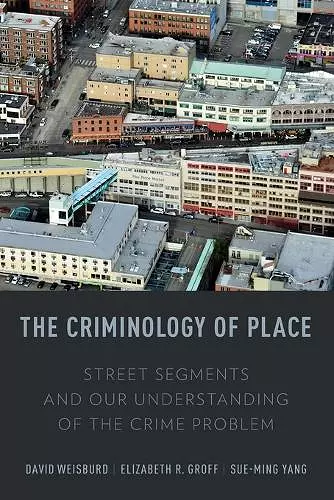The Criminology of Place
Street Segments and Our Understanding of the Crime Problem
Elizabeth R Groff author David L Weisburd author Sue-Ming Yang author
Format:Paperback
Publisher:Oxford University Press Inc
Published:22nd Nov '12
Currently unavailable, and unfortunately no date known when it will be back
This paperback is available in another edition too:
- Hardback£112.50(9780195369083)

The study of crime has focused primarily on why particular people commit crime or why specific communities have higher crime levels than others. In The Criminology of Place, David Weisburd, Elizabeth Groff, and Sue-Ming Yang present a new and different way of looking at the crime problem by examining why specific streets in a city have specific crime trends over time. Based on a 16-year longitudinal study of crime in Seattle, Washington, the book focuses our attention on small units of geographic analysis-micro communities, defined as street segments. Half of all Seattle crime each year occurs on just 5-6 percent of the city's street segments, yet these crime hot spots are not concentrated in a single neighborhood and street by street variability is tremendous. Weisburd, Groff, and Yang set out to explain why. The Criminology of Place shows how much essential information about crime is inevitably lost when we focus on larger units like neighborhoods or communities. Reorienting the study of crime by focusing on small units of geography, the authors identify a large group of possible crime risk and protective factors for street segments and an array of interventions that could be implemented to address them. The Criminology of Place is a groundbreaking book that radically alters traditional thinking about the crime problem and what we should do about it. "This is a very important book for policy-makers, practitioners and academics. The authors carefully and systematically build their case that effective crime prevention efforts must be focused first on a small number of high crime problem places. The detail of their arguments transforms hotspot policing and prevention in the same way keyhole surgery has transformed medical care. Their case is persuasive and, above all, evidence based" -- Peter Neyroud CBE QPM, University of Cambridge and Former Chief Constable and Chief Executive of the National Policing Improvement Agency
"No one in policing, probation or city government can afford not to read this book. David Weisburd and his colleagues have assembled the most comprehensive account ever of where crime happens. Ignoring what they say is like ignoring a tornado warning." -- Lawrence W. Sherman, Wolfson Professor of Criminology, Cambridge University, and Distinguished University Professor, University of Maryland, College Park. "Criminology has been invigorated by an ecological tradition that takes variation in crime across neighborhoods as its unit of analysis-not the individual. Weisburd, Groff, and Yang drill down further and examine variation in crime by street segments within neighborhoods. Enriching and extending the ecological tradition, The Criminology of Place derives new insights and provides the fullest explanation yet of how "micro places" influence the incidence of crime. The book is a welcome and important contribution to criminology with distinct policy implications." -- Robert J. Sampson, Henry Ford II Professor of the Social Sciences, Harvard University and author of Great American City: Chicago and the Enduring Neighborhood Effect "This is a very important book for policy-makers, practitioners and academics. The authors carefully and systematically build their case that effective crime prevention efforts must be focused first on a small number of high crime problem places. The detail of their arguments transforms hotspot policing and prevention in the same way keyhole surgery has transformed medical care. Their case is persuasive and, above all, evidence based." -- Peter Neyroud CBE QPM, University of Cambridge and Former Chief Constable and Chief Executive of the National Policing Improvement Agency "The Criminology of Place represents an important advance in our understanding of the nature of urban crime problems. It is very well written and comprehensive in its coverage of relevant empirical and theoretical criminological research. The book also presents new data on and empirical analyses of the nature of crime problems at places. The visually-striking color maps and graphs provide clear and easy-to-understand summaries of the authors' key research findings and arguments. This book is a must read for city managers, politicians, police executives, community leaders, and others interested in dealing with urban crime problems in a more effective way." -- Criminal Law and Criminal Justice Books
ISBN: 9780199928637
Dimensions: 155mm x 234mm x 15mm
Weight: 635g
288 pages